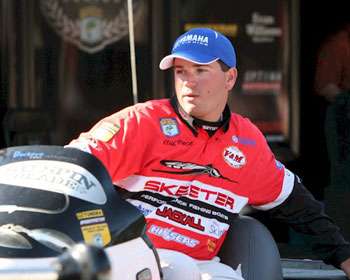
For Elite Anglers, lure customization is a way to gain an edge on the competition and put a few extra bass in the livewell. New hooks, different size split rings and maybe a feathered treble hook are all quick and common additions to hard baits. While new accessories are nice, sometimes a bait needs a whole new wardrobe.
Elite Series pro Cliff Pace has some tips for painting crankbaits that can change you from a finger painter into a casting Picasso.
When it comes to altering the color patterns of a crankbait, Pace must first have a reason to make a change from the color pattern the bait sports right out of the package. "We are on the same lakes for five to seven days in a row, so if I'm catching bass and the conditions change, it's nice to have a bait that is similar to what I was throwing but has a little bit more attraction to it," says Pace. His solution is a daub or two of paint.
According to Pace, many anglers tend to go overboard once they get an airbrush or marker in their hands. "Typically, I don't repaint the whole bait," he allows. "I'll take a factory color that I like and then add a little accent color. I probably have more painted baits than unpainted baits in my boat right now. It's pretty easy to get carried away with."
When the water muddies, Pace will often customize a productive crankbait with a splash of color. With the addition of an orange patch on the throat of a crankbait or a chartreuse line down the side of a bait, Pace is able to match the conditions without changing his presentation. "It gives me more options with the baits that I use," he explains.
When facing clear water, Pace might take the opposite approach and actually remove color from his crankbait. With a piece of sandpaper, he will roughs up and scrapes off the glossy finish and then reseals the bait with a clear coat, giving the bait a matte finish that reduces flash.
For an on-the-water adjustment or for anglers who are unfamiliar with an airbrush, Pace says that there is a quick fix that is as simple as a trip to the local tackle shop or craft store. "One of the easiest things that you can do is buy a set of Spike-It pens," he allows. "Sharpies will work, but the Spike-It pens come in more fisherman-friendly colors. In an instant, you can add a chartreuse pin line down the side of a bait or add a splash of color to the throat. It's a temporary fix but it allows you to create the perfect tool for the job."
When it comes to creating completely custom colors, Pace often airbrushes patterns that are not widely available on the shelves. "Quality perch patterns are not available in a lot of good crankbaits, so when we go to places like Oneida Lake, I'll paint a few perch patterns in order the 'match the hatch,' " he says.
Pace says that novices with an airbrush should expect a learning curve. "If you start getting into custom painting some of your baits, you're going to foul some up. That's just the nature of the beast," he admits. Rather than ruining an expensive crankbait with a sub-par paint job, Pace recommends starting with a water-based paint which can be easily wiped off after a less-than-desirable effort.
At times, Pace's paint jobs are born out of necessity — to give new life to a proven producer. "A lot of the older baits that I have are harder to come by, and they'll often start to crack or leak and fill with water," explains the Mississippi pro. "I'll take some epoxy, fill in the cracks, sand it smooth, repaint the bait, and it's as good as new."




